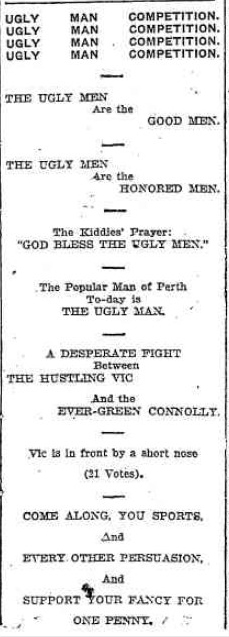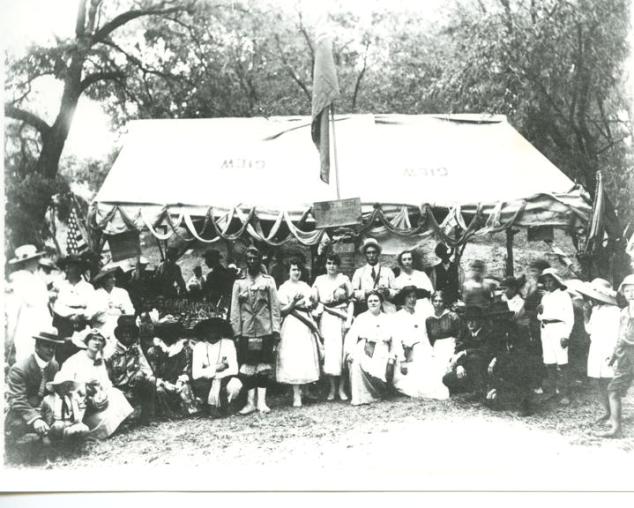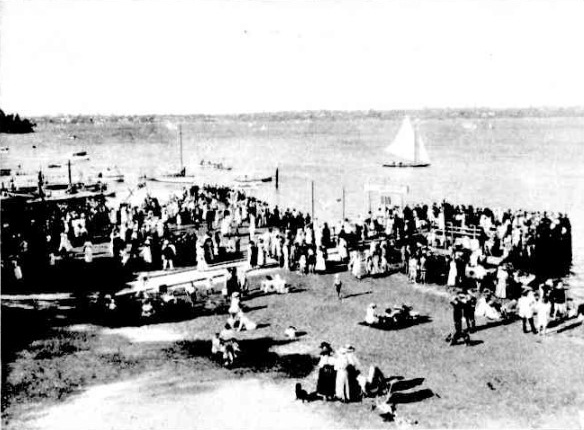Published on Saturday, 1 December 2018 at 11:17:00 AM
Who were the Ugly Men? The Ugly Men’s Voluntary Workers’ Association was a uniquely Western Australian organisation that aimed to raise money to alleviate community suffering caused by World War I.
The problems addressed by the Association included the welfare of soldiers and their dependants, newly arrived immigrants and the development of the state’s rural industries, through the operation of a boys’ farm school at Bundidup. The Ugly Men were instrumental in activities such as building houses for the dependents of those killed in the war, assisting widows to open businesses, supplying clothing and food, and providing funds to hospitals. The money for these ventures came from fundraising activities, and free labour offered by their members, who were mostly working class tradesmen.

The association formed in 1917. At its peak in the 1920s, the Ugly Men raised £12,000 annually for 7,000 applicants for relief.
The Ugly Men became known for their inventive ways to raise funds, including fetes, gala days, picnics, contests and carnivals. ‘Ugly Man’ competitions were popular events across the city, as seen by this 1917 advertisement in The Daily News. Nominations and voting required a coin donation.
A typical newspaper report about the Ugly Men’s Association and their activities would read like this one from 1920:
The usual fortnightly meeting of the Ugly Men’s Association was held on Monday night, when the following members of the executive were present:-Messrs. Clydesdale (chair), Barrett, Hodge, Levy, Newman, Norton, O’Connor, Jacobson, and Rhodes. The following branches were also represented by their delegates:-Bayswater, Cottesloe, Cottesloe Beach, Guildford, Leederville, Maylands, Midland Junction, Queen’s Park, South Perth, Subiaco, and North Perth. A large volume of business was transacted, the number of cases dealt with totalling 49. During the fortnight financial assistance was given in 65 cases amounting to £106 12s. Clothing, bedding, and food were supplied in 23 cases, amounting to £94 7s 6d and 35 blankets were distributed.
The West Australian, 5 June 1920, p. 8.
The Cottesloe Beach (Mosman Park) branch

Ugly Men’s Association picnic, Mosman Park c 1920.
In 1917 an article in The Daily News stated:
Last Saturday the ‘Uglies’ were toiling their hardest at Claremont, Fremantle, Subiaco, and Leederville with the result that good progress was effected towards the completion of four war widows’ homes. At Claremont the efforts of about 40 volunteers made an appreciable addition to the dwelling being built for a deserving widow and her seven children. … It has been decided to form a branch of the Ugly Men’s Association at Cottesloe Beach. To this end a meeting of all interested is convened for the Road Board Hall, at Cottesloe Beach, on Wednesday, October 3, at 8 p.m. The secretary (Mr. J. McEwan) intimates that willing workers, not talkers, are wanted.
The Daily News, 28 September, 1917, p. 7.
Frederick Mann was the first President of the Cottesloe Beach branch. They organised projects such as clearing and filling in the foreshore between the Mosman Bay boat shed and jetty. This gave unemployed men the opportunity to work for the Road Board.
The Mosman Bay foreshore was the focal point of much of the local branch’s activities. A popular annual local Ugly Men’s event was a three-mile swimming race held from the Mosman jetty which began in 1919. The race started at the jetty, before heading around a buoy to Point Walter spit and Keane’s Point, and back to the jetty. In its inaugural year, the first man to finish was Rolf Nyman, son of the stationmaster, and Ivy Bentley was the first woman to finish. The annual event also included a yacht race, for which in 1920 the first prize was £3.3s cash, and a medal for the skipper.
The carnival and regatta held at Mosman’s Bay on Saturday afternoon, in aid of the funds of the Cottesloe Beach Ugly Men’s Association proved a decided success inasmuch as it is anticipated that about £200 will be placed to the credit of this body as the outcome of the day. The event was organised by Mr. J. Norris, assisted by Mr. F. Graves, and Mr. Norris was successful in securing a very handsome number of trophies. The grounds were dotted with stalls, booths, etc., at which refreshments, edibles, and other good things were on sale. In addition, many avenues were offered those with a sporting bent to “try their luck.”
Western Mail, 7 March 1919, p. 31.

Demise of the Ugly Men
In 1929, membership to the Ugly Men’s Association totalled 2,588, of which 2,533 were life members. The association was struggling to attract new and younger members. Cottesloe Beach was listed as a branch in 1929, but had not raised any funds that year and distributed only £7 to the local community. It seems the branch dissolved soon after.
The main source of income for the Ugly Men was the annual ‘Uglieland’ carnivals at Phillimore Street, Fremantle, and ‘White City’ at the river end of William Street in Perth. These events drew thousands of people but in the late 1920s began to attract the wrong sort of publicity. They were seen as a demoralising influence over the young, and ‘a magnet for larrikins and loafers, who, in various stages of intoxication, make for its gates when the hotels are closed.’
The government ordered the closure of ‘White City’ in 1929, after which the financial position of the Ugly Men’s Association declined. In 1933 the government proposed the Lotteries Bill, which aimed to set up a Commission to conduct lotteries for charitable purposes. Since at that time the Ugly Men’s Association controlled the charities with State sanction, it was part of the Bill that the present Ugly Men’s Committee be appointed as the first Lotteries Commission members. Fremantle’s ‘Uglieland’ ran until 1936, but after that the organisation fell into inactivity and went into recess at the outbreak of World War Two.
The Ugly Men’s Association was a major force in the cultural life of Perth in the 1920s. A wonderful band of voluntary workers provided not only material relief from poverty and hardship but also a great deal of entertainment along the way.
Back to All News